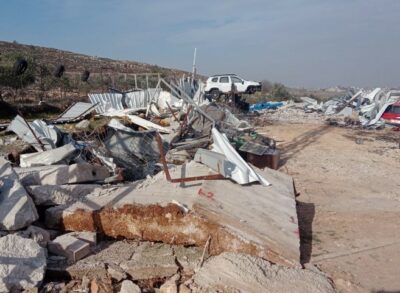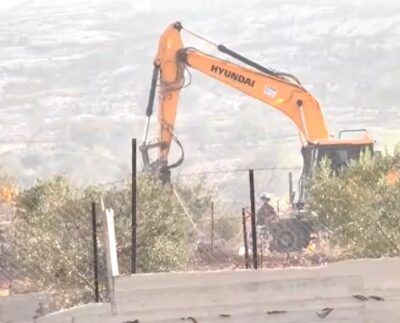On Tuesday morning, Israeli soldiers demolished sheds and walls in the Al-Jeeb town, northwest of the occupied Palestinian capital, Jerusalem, in the West Bank.
Samer Abed-Rabbu, the mayor of Al-Jeeb, said several army jeeps and bulldozers invaded the As-Sahel area in the town and demolished a 250 square-meter shed and several walls owned by Samih Abu Dayya.
 He added that the soldiers surrounded the area to prevent the Palestinians from entering it and demolished the properties.
He added that the soldiers surrounded the area to prevent the Palestinians from entering it and demolished the properties.
On November 28th, the Israeli Army invaded Al-Jeeb and demolished a plant nursery in the Al-Khalayla area in the town.
The Army claims the properties, built on privately owned Palestinian lands, were not licensed by the “City Council” in occupied Jerusalem.
On Monday, a Palestinian from the Al-Isawiya town east of Jerusalem, in the West Bank, was forced to demolish his under-construction home.
This happens while Israel continues to build and expand its illegal, segregated colonies in the occupied West Bank, including Jerusalem, in direct violation of International Law, the Fourth Geneva Convention, and various United Nations and Security Council resolutions.
Israel’s colonies in the occupied West Bank, including those in and around occupied East Jerusalem, are illegal under International Law, the Fourth Geneva Convention, and various United Nations and Security Council resolutions. They also constitute war crimes under International Law.
Article 49 of the Fourth Geneva Convention states: “The Occupying Power shall not deport or transfer parts of its own civilian population into the territory it occupies.” It also prohibits the “individual or mass forcible transfers, as well as deportations of protected persons from occupied territory.”
On its webpage, the Israeli Committee Against House Demolitions (ICAHD) stated that in 2021, ICAHD analysis revealed that 937 structures were demolished and 1,119 people displaced in the OPT, with a further 12,658 people directly affected. In addition, 3004 structures were demolished in the Negev/Naqab – 431 homes and 2553 agriculture and livelihood structures.

